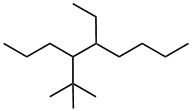 |
|
 |
|
For systems named with simple substituents, the following rules apply:
| 1-ethyl-2-methylcyclohexane not 2-ethyl-1-methylcyclohexane or 1-ethyl-6-methylcyclohexane |
 |
The
numbering is determined by the alphabetisation: ethyl preceeds methyl so ethyl gets the lower
number. But then we number counter-clockwise to give the methyl the
lower number (2- vs 6-) |
| 4-(1,1-dimethylethyl)-5-ethylnonane not 5-ethyl-4-(1,1-dimethylethyl)nonane (the details of naming complex substituents is covered later) |
 |
The
order is determined by the alphabetisation: the dimethyl of the complex substituent
preceeds the simple ethyl
substituent. |
| ©Dr. Ian Hunt, Department of Chemistry |